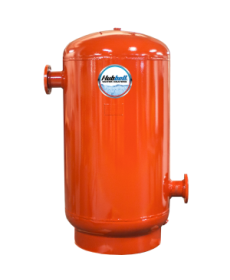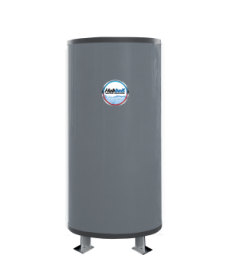
Carbon Steel Buffer Tanks
Hubbell Buffer Tank
Carbon Steel Construction
Long Warranty
ASME Section VIII Division 1

Carbon Steel Buffer Tank Product Description
The primary function of a buffer tank is to prevent short cycling of a boiler or chiller. Our carbon steel buffer tanks store energy produced in a boiler or chiller and release this energy as required into the system. Typical systems operate well below design loads and the use of a buffer tank introduces this stored energy in lieu of cycling the boiler or chiller, this reduction in cycling increases equipment longevity.
Hubbell offers traditional two and four port design configurations with a range of connection sizes as referenced in our submittal data sheets. To meet the wide scope of job site specific connection sizes, the Hubbell buffer tank can also be configured with owner specific requirements.
Features
Specifications
- Designed and constructed per ASME Section VIII, Division 1
- Construction: Carbon Steel with Exterior red oxide primer finish
- Maximum Design Pressure and Temperature: 160 psi @ 450°F
- Registered with the National Board of Pressure Vessel Manufacturers
- Warranty 5 Years
Optional Features
- 304 SS or 316L SS construction
- Higher design pressures and temperatures
- Alternate Connection sizes available
- Insulation and Jacketing
Dimensions


Note: Additional sizes available up to 5,000 gallons, Horizontal configuration available, please contact us direct. *Secondary inlet/outlet dimensions need to be specified.
FAQs
What temperature should I set my water heater?
For typical domestic potable hot water service the temperature of your water heater at 125°F is sufficient. This prevents wasted energy (which means cost savings for you) and also decreases the possibility of scalding water burns. If you run out of hot water on this setting, increase the temperature by five degrees incrementally until your hot water needs are met. The goal is to have the temperature set just high enough to meet your needs but within safe operating parameters. Please note that a water heater in and of itself should not be relied upon as the ultimate temperature controlling source for the hot water delivered to your fixtures. Please consult local and state codes for installation of the proper and code approved (ASSE 1016, 1070, 1017) mixing devices to achieve the safe delivery of hot water to the fixtures. For a more complete information please download the whitepaper PDF titled "Understanding Potential Water Heater Scald Hazards" developed by ASSE at the following link ASSE Whitepaper
Do I need to install an insulation blanket?
No. Most new electric water heaters are highly efficient with respect to the amount of heat loss radiating from the storage tank. This is due to the use of “blown in” polyurethane foam insulation as the insulating method for modern tanks, compared to the fiberglass blanket style insulation used by water heater manufacturer’s largely in the past. As such there is little to no benefit, and very possibly a detrimental effect to efficiency, installing an insulation blanket on a new electric water heater constructed with foam insulation.
Is it OK to use softened water with my cement lined tank?
Yes it is OK. A water softener system will not affect the longevity or operation of a Hubbell cement lined water heater tank. A water softener is typically installed when a potable water system has hard water resulting in the need to soften the water. Unfortunately, the salt used in a water softener corrodes the anode rod and exposed steel surfaces of the water heater tank, rapidly causing a glass lined water heater to corrode and leak within a few years. This is an issue for a glass lined water heater due to its reliance on a sacrificial anode, however because a cement lined tank does not use a sacrificial anode softened water is of no concern to the Hubbell cement lined tank.
What is a sacrificial anode and does a cement lined tank need one?
All water heaters constructed using a steel tank requires a lining to protect the internal steel surfaces from corrosion. Certain linings (i.e. glass and epoxy), due to their nature, have unavoidable holes and imperfections resulting in exposure of the steel tank. As a result of this deficiency, the manufacturer will install an anode rod(s) in an attempt to delay corrosion of the steel tank. An anode rod is typically made of aluminum, magnesium or zinc, is a maintenance item that requires periodic inspection and replacement, and is often times the cause of a “rotten egg” odor to your hot water. Often referred to as a sacrificial anode rod because, over time, it slowly dissolves, sacrificing itself as it is attacked by aggressive substances in the water which would otherwise attack the steel tank through the pinholes and imperfections of the glass or epoxy lining. A cement lined steel tank on the other hand does not require an anode because of the thickness and guaranteed 100% coverage of the cement lining over all internal surfaces of the steel tank. This eliminates the need for an anode rod in a cement lined water heater, resulting in a significantly longer life compared to a glass or epoxy lined water heater. For a further discussion please click on the following link Cement Lining
What is the max water temperature setting?
The Hubbell cement lined tank is suitable for storing water up to 194°F. However, it should be noted that your water heater will likely require optional control accessories to achieve this temperature, but there is no concern regarding the ability of the lining to withstand this temperature. Additionally, there are numerous safety concerns that must be considered when storing water at elevated temperature, please consult factory.
Which is better for me, a tankless or storage type water heater?
It depends. A tankless water heater is sometimes referred to as a Point-of-Use (POU) or instantaneous water heater. Due to the relative small physical size of a tankless water heater compared to a storage tank water heater, a tankless option can be advantageous from a space saving perspective and can sometimes be installed closer to where you want hot water (hence the term POU). However, tankless heaters are not suited for many applications, so it is critical that before choosing to go tankless you have carefully considered all of the factors that sometimes make the tankless option more complicated and risky compared to a storage type water heater. In particular, you should understand the operational characteristics, maintenance requirements, reparability, and sometimes significant installation requirements of a tankless water heater before making a decision. Tankless units do not store heated water like a storage type water heater; they only heat water as there is demand and therefore must be sized to meet the maximum flow for the application. In some cases a tankless water heater may improve operating efficiency, but possibly at the expense of user comfort. Hubbell tankless water heaters are available inElectric Tankless or Gas Tankless.
What is the water pressure drop through the tank?
There is no major restriction of water flow through the Hubbell water heater. Cold water inlet and hot water outlet sizes are available in ¾” and 1-1/2” sizes to accommodate your application. By far, the ¾” size is more than adequate for most applications using a model E water heater. If your flow rate through the water heater is greater than approximately 10 GPM you may want to consider the 1-1/2” connection option (must be specified at time of ordering). As an approximate, pressure drop through any E model water heater with ¾” connections will be <4 psi with a flow rate of <10 GPM, and with 1-1/2” connections the pressure drop will be <3 psi with a flow rate of <20 GPM.
Do I need a drain pan under my heater?
Yes, Hubbell advises that a drip pan with a proper drainage connection be installed under your water heater. In some locations drip pans are required by code and in other situations they are highly recommended, but not required. In either case, if a water heater leak or a dripping relief valve could result in property damage then a drip pan must be installed under the water heater, even when not required by code.
Is there a cold water dip tube in the Hubbell tank?
Not exactly. The Hubbell cement lined tank includes a cold water diffuser integrated into the cold water connection which allows incoming cold water to be introduced into the tank in a controlled and non turbulent manner, thus avoiding premature mixing of cold water with the hot water in the tank. On Hubbell cement lined tanks the cold water inlet/diffuser is located on the side in the lower portion of the tank. Therefore, a Hubbell cement lined tank does not require a long dip tube extending all the way from the top to the bottom of the tank as is common in glass lined tanks.
How does my water heater ship?
All Hubbell storage type water heaters ship via common carrier and are classified by the Commodity Classification Standards Board under National Motor Freight Classification (NMFC) class 100. Each water heater is palletized and wood crated. All Hubbell tankless water heaters, when transported using common carrier, ship class 77.5. To provide the lowest transportation cost, in most cases the shipment is made on Hubbell’s account and the freight cost is added to the invoice, commonly referred to as “Pre pay and add”. For very large shipments, the most economical method (LTL or Dedicated Truck) for transporting the water heaters to the final destination will be analyzed by Hubbell's transportation department.
Why is Hydrastone Cement a better choice over glass lining?
Cement lining provides guaranteed 100% coverage with a minimum thickness of 0.5” over all internal tank surfaces. In comparison, glass lining is approximately 0.005” thick and includes imperfections, pinholes and variation in coverage thickness resulting in portions of unprotected steel tank exposed to corrosion. In an attempt to compensate, glass lined tanks include a sacrificial anode in an effort to slow down the corrosion of the tank. Cement lined tanks on the other hand do not require an anode due to the integrity of the lining. As such, a cement lined tank will far outlast a glass lined tank. For a more complete explanation of the benefits of the Hubbell cement lining please click on the following link Cement Lining
Do Hubbell water heaters qualify as Low Lead?
Yes, all Hubbell water heater models qualify as meeting the low lead requirements of the “Reduction of Lead in Drinking Water Act” amendment to the “Safe Drinking Water Act” (SDWA) Section 1417(d) effective as of January 4, 2014. Hubbell certifies that its water heaters meet the following requirements of the SDWA and therefore are qualified and certified as Low Lead : (a)Hubbell water heater do not contain more than 0.2 percent lead with respect to solder and flux (b)Hubbell water heaters do not contain more than a weighted average of 0.25 percent lead with respect to all wetted surfaces of the water heater
Warranty
Hubbell shall warranty all electrical components against defects in workmanship and material for a period of one (1) year from date of start-up, and the pressure vessel for a full five (5) years Non Pro-Rated (Square Optional: Full ten (10) yeas Non Pro-Rated) from date of start-up, provided that the unit is started within three (3) months of date of shipment and installed and operated within the scope of the tank design and operating capability. Labor is not covered under warranty. Each heater shall be shipped with a complete set of installation and operating instructions including spare parts list and approved drawings.
Technical Support
Our Technical Support Reps are ready to assist you. Please contact us today.



